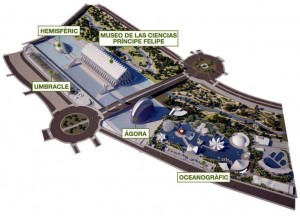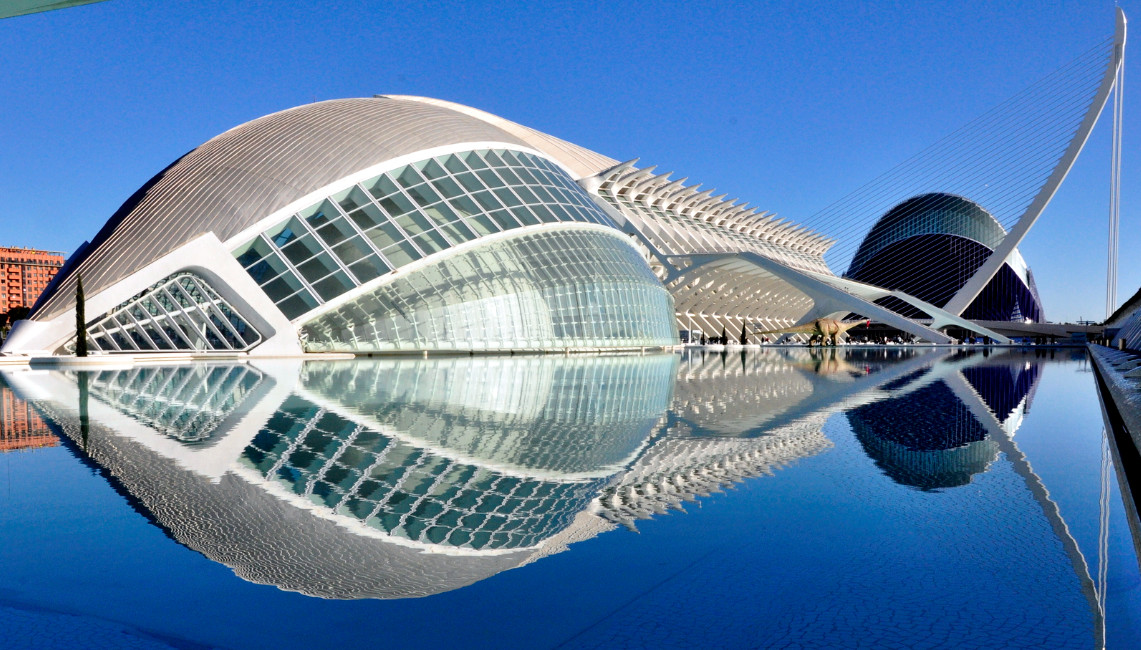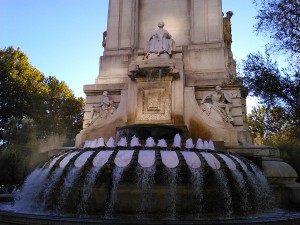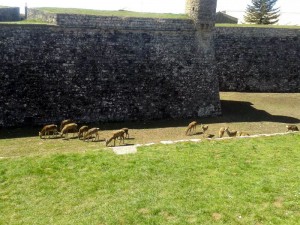Located in Valencia, The City of Arts and Sciences (Ciudad de las Artes y las Ciencias) is a complex of futuristic buildings in where visitors can discover one of the greatest aquariums of Europe, a science and technology museum, cinemas, a theater and many more cultural zones. It also has leisure areas with gardens, lakes and restaurants.
 It was designed by the famous architect Santiago Calatrava and finished in 2002. The budget was initially of 600 million euros, but at the end it cost four times more, which generated a lot of polemic among the population because of its high cost. However, nowadays most people agree on considering the City of Arts and Sciences as the more important touristic attraction of Valencia, and one of the places that tourists must see when visiting Spain.
It was designed by the famous architect Santiago Calatrava and finished in 2002. The budget was initially of 600 million euros, but at the end it cost four times more, which generated a lot of polemic among the population because of its high cost. However, nowadays most people agree on considering the City of Arts and Sciences as the more important touristic attraction of Valencia, and one of the places that tourists must see when visiting Spain.
To arrive at Ciudad de las Artes y las Ciencias you can take the bus (Lines 1, 13, 15 35, 47 and 95). Also you can go by metro (Line 5) to Ayora or Maritim Serreria Stations (15 minutes away on foot).
What to visit in City of Arts and Sciences?
The City of Arts and Sciences consists in a wide zone in the center of Valencia, near the sea and the Port of Valencia, in where are located the followings cultural and leisure buildings and structures:
 – The Hemisferic (3-D IMAX cinema): Inside this impressive building, which is one of the main icons of the city, you will find the bigger cinema hall of Spain. Its exterior shape of its white structure surrounded by water represents a human eye.
– The Hemisferic (3-D IMAX cinema): Inside this impressive building, which is one of the main icons of the city, you will find the bigger cinema hall of Spain. Its exterior shape of its white structure surrounded by water represents a human eye.
– The Oceanográfic: The biggest aquarium of Europe with more than 10,000 square metres and which has around 45,000 living beings. It is composed by several separated zones in where are represented these environments: The Mediterranean sea, The tropical zones, Ocean Environments, Antarctic and Arctic, Islands and Humid regions. Moreover, it includes a dolphin area and a submarine restaurant.
– Museo de ciencias Príncipe Felipe (Sciences Museum): A science museum in where young and older people can discover the principles of the 21th century science and technology by touching and doing interactive experiments.
 – Sophie Queen Arts Palace (Theater): The Palau de les Arts Reina Sofía has four big theater halls dedicated to classical music, opera and theater plays. It also includes an additional zone for expositions.
– Sophie Queen Arts Palace (Theater): The Palau de les Arts Reina Sofía has four big theater halls dedicated to classical music, opera and theater plays. It also includes an additional zone for expositions.
– The Agora (Square-Pavilion): A Pavilion for events, as concerts or similar activities.
– The Umbracle (gardens): A view point from where the people can observe the whole complex of buildings. The Umbracle include gardens and paths to walk and discover regional plants, statues and sculptures.
More places to visit in Valencia
– The Turia Gardens: A public green park of more than 7,000 metres long with great variety of trees, plants ,flowers, herbs, grass, many fountains, several sports areas, some playgrounds, a lot of places to relax and rest, so on.
– The Silk Market: A must for visitors who arrive in Valencia is the Silk Market (la Lonja de la Seda). It’s a masterwork of the 15th century declared a world Heritage site by UNESCO in 1996.
Read also our post with the best monuments and buildings to visit in Spain.






























